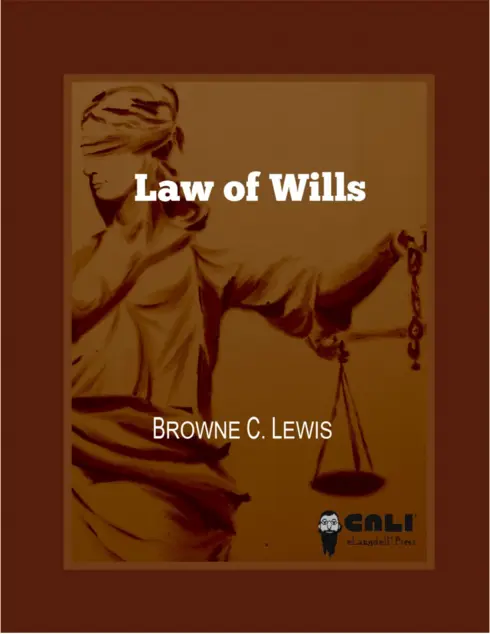
Law of Wills
No ratings
Browne C. Lewis, Cleveland-Marshall College of Law
Copyright Year:
Publisher: CALI's eLangdell® Press
Language: English
Formats Available
Conditions of Use
![]() Attribution-NonCommercial-ShareAlike
Attribution-NonCommercial-ShareAlike
CC BY-NC-SA
Table of Contents
Part I – The Intestacy System
- Chapter One: Ethically Representing the Elderly Client
- Chapter Two: Intestacy System (Basic Overview)
- Chapter Three: Intestacy System (Surviving Spouse)
- Chapter Four: The Intestacy System (Marital and Adopted Children)
- Chapter Five: Intestacy (Non-Marital Children, Stepchildren and Foster Children)
- Chapter Six: Intestacy (Children of Assisted Reproductive Technology)
Part II —The Testacy System
- Chapter Seven: Testamentary Freedom
- Chapter Eight: Disinheritance
- Chapter Nine: Testamentary Capacity (Mental Competency and Insane Delusion)
- Chapter Ten: Testamentary Capacity (Undue Influence, Duress and Fraud)
- Chapter Eleven: Attested Wills
- Chapter Twelve: Non-Attested Wills
- Chapter Thirteen: Additional Doctrines Impacting Wills
- Chapter Fourteen: Mistakes and Curative Doctrines
- Chapter Fifteen: The Stale Will Problem
Part III — Nonprobate Transfers
- Chapter Sixteen: Will Substitutes
About the Book
The purpose of this casebook is to train law students to think and act like probate attorneys. This book is meant to be used in conjunction with the author's book on the law of trusts. This book's focus is problem-solving and legal application; the book includes numerous problems, so law students can learn to apply the law they learn from reading the cases. It also contains collaborative learning exercises to encourage students to engage in group problem-solving. The book is divided into three parts to reflect the main types of issues that students will encounter if they practice probate law. The book's organization mirrors the manner in which probate law is practiced in the real world.
The book starts with an examination of the intestacy system because the majority of people die without executing a will. Therefore, most of the legal issues a probate lawyer faces center around the intestacy system. Unlike the typical wills casebook, this book provides a detailed discussion of the intestacy system. A chapter on ethics is included because probate attorneys encounter ethical issues that are different from attorneys practicing in other areas of law.
The second part of the book includes an exploration of the testacy system. It is arranged so professors can lead students from the client interview to the will execution. The first three chapters of this section deal with issues that directly impact the existence of the inheritance system. It analyzes a person's ability to control the disposition of his or her property after death. This serves as the students' first introduction to the power of the “dead hand”. These chapters are included to start a public policy discussion about the rights of the dead, the right of heirs, and the necessity of an inheritance system. I tell my students that, when executing a will, they must think of the ways that it can be contested. In addition, I tell them that a will can be contested on two fronts-an attack on the testator and an attack on the will. Two chapters in this part highlight the ways that the testator's ability to execute a valid will may questioned.
The final chapters in this unit show the issues that can be raised to dispute the validity of the will. They also explain the different types of wills that are available. The final part of the book deals with non-probate transfers. These chapters are included to show students the other devises that people can use to distribute their property. That knowledge is important because the majority of people use these procedures to transfer their property. At the end of the semester, my students have to draft a will based upon a fact pattern that I give them. I intentionally include non-probate property in order to see if they will attempt to distribute that using the will.
About the Contributors
Author
Professor Lewis is the Leon & Gloria Plevin Professor of Law and the Director of the Center of Health Law & Policy at Cleveland-Marshall College of Law. Prior to joining the faculty at Cleveland-Marshall, Professor Lewis was an associate professor at the University of Detroit Mercy School of Law, a visiting professor at the University of Pittsburgh School of Law, a summer visiting professor at Seattle University School of Law and a legal writing instructor at Hamline University School of Law. Professor Lewis has also taught in the American Bar Association CLEO Summer Institute.
Professor Lewis has been a visiting scholar at the Brocher Foundation in Geneva, Switzerland, the Hasting Center, and Yale University’s Interdisciplinary Center for Bioethics. As a Senior Fulbright Specialist, Professor Lewis conducted research at Hebrew University and Haifa University in Israel. Professor Lewis was also a Core Fulbright Scholar at King’s College in London, and a Robert Wood Johnson Public Health Law Scholar in Residence at the Cleveland Public Health Department.
Professor Lewis writes in the areas of estate planning, probate and reproductive law. Her article on human oocyte cryopreservation was recently published in the Tennessee Law Review. In 2012, New York University Press published Professor Lewis’ book on paternity and artificial insemination. Professor Lewis has recently completed a book on posthumous reproduction for Routledge Press.
Ancillaries
Student Resources
- CALI's eLangdell® Press (by request)
